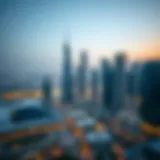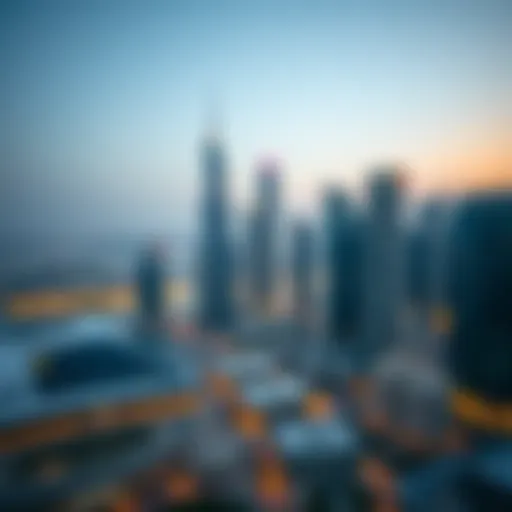Creek Gates: Their Role in Dubai's Real Estate Development


Intro
In the context of Dubai's ever-evolving real estate scene, creek gates represent more than just architectural features; they are vital conduits that bridge the city's rich history with its ambitious future. As prosperity flows through Dubai's neighborhoods and across its waterways, the creek gates emerge not simply as functional installations but as pivotal elements that enhance urban living, eco-sustainability, and community interactions. Understanding the essence of creek gates allows for an appreciation of their role in reinforcing property value and shaping the way residents and visitors experience this vibrant metropolis.
Over the years, as the city has grown from a modest fishing village into a global powerhouse, the creek gates have served as silent witnesses to this transformation. Their presence signifies not only a connection to the past but also an important aspect of forward-looking urban planning. By examining the significance of creek gates, the readers dive deeper into their contribution to both the real estate market and the broader community ethos that characterizes Dubai today.
As we explore the dynamics surrounding these structures in the following sections, readers will gain valuable insights into their importance within the urban fabric and what they mean for prospective homeowners, investors, and anyone keen on understanding the real estate landscape of Dubai. From burgeoning neighborhoods to sustainable living practices incorporated into their designs, creek gates are key to unlocking the potential of this city. Let’s dive into the current market trends.
Preface to Creek Gates
In the vibrant tapestry of Dubai's urban landscape, creek gates play a pivotal role in shaping not just the physical environment, but also the socio-economic fabric of the city. These structures serve as gateways between land and water, embodying both functional utility and aesthetic appeal. Understanding creek gates means appreciating their significance in urban planning, environmental stewardship, and community integration within the ever-evolving real estate market of Dubai.
Defining Creek Gates
Creek gates can be defined as structures built along the waterfront that manage the flow of water into and out of specific areas. They often serve multiple purposes, including flood control, navigation, and habitat protection. More than mere barriers or entry points, these gates help regulate the health of waterways that are vital to the local ecosystem.
In Dubai, where the sea meets the city, creek gates are essential in balancing development with ecological considerations. The gates can vary in style and function—from traditional designs echoing the city's rich maritime history to modern installations showcasing innovative engineering solutions. Each design serves a purpose that transcends aesthetics, aiming to facilitate sustainable interaction between urban life and nature.
Historical Background
The history of creek gates in Dubai is steeped in the city’s journey from a humble fishing town to a bustling metropolis. Initially, the creeks were the lifeblood of the community, serving as vital trade routes. Early settlers, understanding the significance of water management, constructed basic forms of gates to control the flow of tidal waters, primarily to protect their small boats and ensure safe passage.
As the city burgeoned with its economic boom in the late 20th century, the role of creek gates evolved dramatically. Infrastructure development necessitated more sophisticated designs capable of accommodating increased maritime traffic and urban runoff. The interaction between architecture and engineering became crucial, leading to the formation of complex systems that not only regulate water but also enhance the aesthetic and functional aspects of surrounding developments.
Today, the historical legacy of creek gates coexists with modern design, creating a unique backdrop that is quintessentially Dubai. Their significance is underscored by the city’s commitment to blending heritage with contemporary urban needs, making them a vital element in both the narrative and physical layout of Dubai’s extensive real estate landscape.
Cultural and Historical Context
The discussion of creek gates in Dubai extends beyond mere engineering; it taps into the essence of the city’s evolution. Creek gates symbolize a significant intersection of culture and history, reflecting how Dubai has harnessed its natural resources to inform urban development.
Waterways have historically acted as veins of economic activity, nurturing trade and culture while shaping community identities. The critical role of these gates ties into larger narratives. Dubai’s growth as a commercial hub can be distinctly traced along its waterways, where early trading activities first flourished due to the natural harbor provided by Dubai Creek. This section aims to underline how integral creek gates are to this constantly evolving landscape.
The Role of Waterways in Dubai's Development
Creek gates serve as pivotal points within Dubai's waterway systems. Historically, waters were the lifeblood of this trading city, facilitating not just economic interactions but social ones too. The waterways connected various facets of life, allowing for a blend of cultural exchanges that were instrumental in shaping Dubai’s identity.
- Economic Growth: The waterways were crucial for transporting goods and services. Early merchants relied on the creek to import spices, fabrics, and precious metals. This economic dependence led to a vibrant local economy that flourished alongside the waterways.
- Cultural Exchange: As trading posts established along these waterways, they brought together diverse cultures. This melting pot scenario fostered a rich tapestry of cultural influences that can still be witnessed today—be it in language, cuisine, or architecture.
Interestingly, creek gates help manage the water levels and maintain the ecological balance necessary for fish species and traditional fishing industries. They not only serve functional purposes but also act as cultural identifiers in the urban fabric of Dubai.
Creek Gates Through the Ages
The architectural evolution of creek gates in Dubai offers a fascinating glimpse into the city’s past. From simple barriers designed to mitigate flooding in the initial phases of urban development, these structures have transformed substantially over time.
In earlier days, creek gates may have appeared rudimentary, primarily made from locally sourced materials. However, with the rise of modernity in the late 20th century, they underwent significant upgrades:
- Modern Materials: New constructions now utilize materials like reinforced steel and glass, enabling more robust and visually appealing designs that harmonize with surrounding landscapes.
- Cultural Resonance: A blend of traditional motifs with modern conveniences has manifested in the design of many gates today. This fusion represents a deeper connection to the city’s past while embracing global architectural trends.
"Dubai’s creek gates stand as not only functional infrastructures but also as historical markers, encapsulating a journey from simple utility to modern artistry."
Dubai's future development still pays homage to these historical elements, ensuring that the evolution of creek gates continues to reflect the city's dynamic narrative. Investors and urban planners alike should understand that these structures embody a symbolic gateway to Dubai’s rich past and aspiring future.
Architectural Significance of Creek Gates
The architectural significance of creek gates in Dubai goes beyond mere functionality; it embodies the essence of the city's identity and its progress. These structures serve as gateways between the historic waterways and modern urban spaces, encapsulating Dubai's unique blend of tradition and innovation. It’s crucial to understand that creek gates are not merely practical but aspire to communicate a narrative about the city’s cultural evolution and urban aspirations.


Design Elements and Aesthetic Considerations
In considering design elements of creek gates, one can observe a distinct harmony between form and function. The gates are often designed to complement their surroundings, featuring:
- Material Choices: Predominantly utilizing concrete and steel, these materials offer both durability and an industrial edge, which marries well with Dubai's skyline.
- Cultural Symbols: Many gates incorporate motifs that resonate with local culture, such as geometric patterns often found in Islamic architecture. This thoughtful integration makes the structures not just utilitarian but aesthetically significant and culturally grounding.
- Lighting: Innovative lighting techniques are commonly employed to highlight the gates at night, fostering an inviting atmosphere. This duality of night and day aesthetics plays a substantial role in creating a lively urban environment,
The community interactions with these structures shift depending on their design qualities. When well-designed, creek gates become vibrant focal points, teasing the senses and encouraging both resident and tourist engagement.
Innovative Engineering Solutions
When it comes to innovative engineering solutions integrated within creek gates, several impressive features have paved the way for extensive use:
- Hydraulic Systems: Advanced hydraulic mechanisms allow these gates to adapt to changing water levels, ensuring the dynamics of the Dubai Creek are managed effectively and maintaining aesthetic appeal.
- Sustainable Technology: Several creek gates integrate renewable energy resources. Solar panels might be embedded in the structures to power lighting, which reflects a commitment to sustainability and modern living.
- Smart Design Practices: Some gates are now being fitted with sensor technology to monitor water quality and environmental changes. This not only ensures functionality but also promotes ecological oversight.
"The architecture of creek gates transcends aesthetics; it's about creating a resilient community framework around the waterways that define Dubai."
As these engineering advancements continue, the creek gates evolve from simple barriers to integral components of urban resilience and environmental integrity. Investors and city planners should view these structures not just as features of a landscape but as symbols of what Dubai can achieve in merging technology and tradition.
Creek Gates and Urban Planning
In the bustling real estate environment of Dubai, creek gates serve a critical function in urban planning. This section delves into how these structures integrate into city landscapes while boosting both aesthetic appeal and community functionality.
Integration of Creek Gates in Urban Design
When urban planners look at creek gates, they see more than just barriers against tide and flood. They are pivotal elements that can enhance connectivity across urban spaces. Incorporating creek gates into designs not only provides practical benefits but also enriches the city’s visual narrative.
Consider the district around Dubai Creek, where gateways serve as ports of entry to vibrant neighborhoods. This layout allows for an flow between the natural waterway and the bustling urban life. Integrating green zones and recreational spaces around these gates further erases the line between built environment and nature.
Key elements of successful integration include:
- Accessibility: Ensuring that creek gates are easy to reach encourages local traffic and tourism.
- Aesthetic coherence: These gateways should complement nearby architectures, facilitating a cohesive look.
- Cultural relevance: Incorporating local materials or artistic representations in the design can strengthen the sense of belonging among residents.
From walking trails to boat docks, the potential for transports and leisure is staggering. As cities evolve, creek gates will likely adapt to keep upper hand on enhancing urban environments.
Impact on Community Spaces
Creek gates bolster community spaces by making them accessible and inviting. These structures transform passive waterfronts into vibrant communal hubs. Local parks near creek gates can become gathering spots for events or leisurely afternoons, which Sunbathers or picnickers can enjoy.
An approach to usable community design includes:
- Plazas and gathering areas: These can be created around creek gates, encouraging interaction among diverse communities.
- Sustainable practices: Development should prioritize eco-friendly practices to protect the delicate ecosystems surrounding these gates.
- Public art installations: Utilizing space for art showcases local talents while beautifying the area.
"The further a city gets from its nature, the more it risks losing its identity."
The social impact of well-planned creek gates cannot be understated. They offer a gateway—quite literally— to a lifestyle that encourages community engagement and appreciation for Dubai’s rich cultural tapestry. By reimagining these spaces as active hubs rather than passive barriers, we foster community pride while addressing urban challenges.
Environmental Considerations
Understanding the environmental considerations of creek gates offers vital insights into how these structures can not only enhance Dubai's real estate landscape but also ensure sustainable urban development. This perspective is pertinent as the city grapples with rapid growth and seeks innovative solutions to integrate natural elements within urban settings.
Ecological Benefits of Creek Gates
Creek gates serve more than just an aesthetic function; they are pivotal in promoting ecological balance within the urban environment. By allowing for controlled water flow, these structures can help maintain healthy ecosystems in surrounding waterways. For example, they can regulate salinity levels, which in turn supports diverse aquatic life crucial for the local fishing community.
"Creek gates operate as lifelines for both urban landscapes and local wildlife, fostering symbiotic relationships essential for ecological sustainability."
Moreover, these gates play a role in biodiversity conservation. They can facilitate the movement of fish and other aquatic species between different habitats, aiding in gene flow and population stability. When combined with strategic landscaping and native plant introductions, they can enhance wildlife habitats, which ultimately translate into benefits for community wellness as well.


Additionally, creek gates can mitigate flood risks by controlling water levels during heavy rains. This becomes increasingly important as climate change impacts weather patterns. By providing a buffer against potential flooding, they safeguard property and enhance the value of investments in the vicinity. These features underscore the importance of creek gates from an ecological standpoint.
Sustainable Practices in Construction
When it comes to the construction of creek gates, sustainable practices are paramount. Implementing environmentally-friendly techniques can lead to not only reduced carbon footprints but also increased resilience of the structures over time.
Key sustainable practices in the construction of creek gates include:
- Use of Recycled Materials: Employing recycled steel or composite materials can drastically reduce the environmental impact associated with new material production.
- Energy-Efficient Designs: Innovative designs that incorporate renewable energy sources for lighting or automated regulation systems can minimize energy consumption.
- Low-Impact Construction Techniques: Methods such as minimal earth disturbance and careful timing of construction activities can preserve local wildlife habitats and mitigate disruptions to the environment.
The commitment to sustainability thus reflects a broader trend towards green building practices in Dubai's real estate sector. Future developments around creek gates may integrate smart technology to optimize functionality while upholding ecological integrity. Consequently, these practices position creek gates not just as structures, but as integral components of Dubai's aspiration for a sustainable urban future.
Creek Gates and Real Estate Dynamics
Creek gates hold a pivotal role in shaping the real estate landscape of Dubai, influencing everything from property values to the flow of investment. As urban planning evolves, these structures become essential not just for their functionality but also for the cultural and aesthetic appeal they bring to neighborhoods. In a city where the skyline is constantly evolving, creek gates act as a bridge between the historical and the modern, offering a unique interface for both residents and prospective buyers.
Influence on Property Values
The mere presence of creek gates can significantly affect property values in their vicinity. Properties that lie close to these water-related infrastructures typically demand higher prices, primarily due to their scenic views and enhanced accessibility. The desirability increases when people consider the additional benefits that come with waterfront living, such as recreational opportunities and increasing foot traffic from visitors.
Several studies indicate that waterfront properties in locations like Dubai can command premiums of up to 30% over comparable properties that are not located near water features. Just imagine sipping coffee while gazing at the shimmering waters, or taking a stroll along landscaped pathways. This vibrant lifestyle draws in a demographic keen on investing in a lifestyle rather than just living space.
It’s important to recognize, however, that this increase in value can fluctuate based on factors such as the economic environment and urban development plans. Investors must keep a close watch on future infrastructural expansions or upgrades that may influence the neighborhood’s appeal.
"Proximity to water has transformed the real estate market, where no longer is it just a commodity, but a coveted lifestyle choice."
Attracting Investors and Developers
Creek gates not only enhance existing properties but also serve as a magnet for investors and developers who are looking for new opportunities. The integration of these structures into urban landscapes often leads to a rise in development projects that might otherwise not have gained traction. This trend is apparent in developments that include mixed-use spaces integrating residential and commercial properties near creek gates.
Investors are increasingly looking at projects around water features as they often assure higher returns on investment over the long term. Factors such as tourism, hospitality, and retail developments cluster around these creek gates, thereby enriching the potential for lucrative partnerships. Developers are more likely to take the plunge on projects that promise easy access to water amenities.
Key considerations for developers include:
- Regulatory compliance: Understanding the legal layout when developing near these waterways is crucial.
- Sustainability focus: As environmental awareness grows, projects that prioritize ecological factors stand a better chance.
- Community input: Engaging with local communities can help gather support and preferences for new developments, ensuring that they align with public sentiment.
Community and Social Impact
The significance of creek gates in Dubai transcends mere structural functionality; they serve as focal points for community interaction and development. These gateways, welcoming water into the urban environment, create opportunities that ripple through both social and economic dimensions. With Dubai positioning itself as a global hub, understanding the influence of these structures on community dynamics is paramount.
Enhancing Community Engagement
Creek gates are much more than barriers or entrances; they facilitate social connections and foster a sense of belonging among residents. Their design often incorporates public amenities like walking paths, gathering areas, and viewpoints, making them attractive locations for community events or daily interactions. These spaces encourage local residents to spend time outdoors, leading to enhanced community bonds.
- Social Hubs: Areas surrounding creek gates often host markets, festivals, and cultural events, becoming vibrant social hubs.
- Accessibility: With improved pathways and transit options, residents can easily access these gates, thus interacting more within their neighborhoods.
- Ecological Education: Local initiatives aimed at educating residents about the ecosystems supported by these gateways promote active community involvement in environmental stewardship.
A practical example is the Dubai Creek Harbour, where community members actively participate in activities organized at creek gates. From art exhibitions to farmer’s markets, these events not only showcase local talent but build connections across diverse populations, reflecting the multicultural fabric of Dubai.
Creek Gates as Public Spaces
Creek gates serve as vital public spaces that blend nature with urban life, enriching the quality of urban experience. With their unique configurations, they often bridge the gap between built environments and natural landscapes. The waterways provide scenic vistas that attract not just residents but also tourists, contributing significantly to the local economy.
- Recreational Areas: Many gates feature recreational areas for families and individuals alike, including picnic spots, fishing areas, and cycling paths. Activities encourage residents to engage with their environment actively.
- Safe Zones: Well-designed creek gates integrate safety elements, allowing families to enjoy public spaces without concerns about traffic or pollution.
- Art and Culture: Public art installations and performance spaces near creek gates enhance cultural expression, inviting artists to showcase local talent, which further engages the community.
"Public spaces like creek gates remind us that urban life can coexist with nature, fostering a balanced lifestyle for all citizens."


In summary, the community and social impact of creek gates in Dubai is multifaceted and profound. They not only enhance the aesthetic appeal of the city but also foster social connections and promote active community engagement. As urban planners and developers consider the future of these structures, ensuring they remain accessible and multifunctional will be key to continuing their role as vital public spaces.
Challenges and Considerations
Understanding the challenges and considerations linked to creek gates is crucial, not only for urban planners and developers but also for those engaged in the dynamic world of real estate in Dubai. It sheds light on how these structures are both a boon and a series of hurdles in navigating the urban landscape. Proper maintenance and regulatory frameworks are pivotal elements that can make or break the functionality and aesthetic contribution of creek gates in any project.
Maintenance and Upkeep
Maintaining creek gates requires a dedicated approach that reflects their significance within the urban ecosystem of Dubai. Due to the harsh environmental conditions, particularly the high salinity from seawater and the excessive heat, regular checks and proper upkeep are essential to prolong their lifespan.
- Structural Integrity: It's not just about keeping them looking pretty; regular inspections save resources in the long run. A small crack today could demand a hefty repair bill tomorrow.
- Cleaning: Silt and debris deposited by waters can hinder functionality, meaning a clean-up crew needs to be in place, especially after storms.
- Community Involvement: Encouraging local community members to participate in maintenance efforts can enhance the sense of ownership and responsibility towards these gateways.
Allocating budgets for ongoing maintenance ensures the creek gates serve their dual role—facilitating passage while enhancing property value. An overlooked creek gate could impact surrounding real estate, making properties less attractive if they appear neglected.
Navigating Regulatory Frameworks
The regulatory landscape governing the construction and management of creek gates cannot be understated. Dubai's development is tightly interwoven with local laws and regulations overseen by various governmental bodies, ensuring that every building and infrastructural installation meets specific safety and aesthetic standards.
- Permits and Approvals: Before proceeding with any construction or renovations, developers must secure the necessary permits. This process can be intricate, requiring in-depth knowledge of local regulations.
- Environmental Compliance: As Dubai becomes increasingly attuned to sustainable practices, creek gates must also adhere to environmental guidelines. This ensures that any construction does not adversely impact the delicate marine ecosystem.
- Stakeholder Engagement: Engaging with local stakeholders—whether governmental agencies, environmental groups, or community members—can streamline the approval process and foster goodwill. Transparency is key.
In essence, seamlessly integrating creek gates into Dubai’s urban fabric requires balanced attention to both day-to-day maintenance and long-term regulatory compliance. This approach not only enhances property values but also fosters a sustainable community dynamic, vital for the city's infrastructural integrity.
"Without careful handling, even the most beautifully designed structures can fall into disrepair, costing more in both finances and community trust."
Overall, addressing these challenges head-on lays a solid foundation for the future of creek gates in Dubai, ensuring they remain a sought-after asset in the ever-evolving real estate landscape.
Future of Creek Gates in Dubai
As we gaze into the future of creek gates in Dubai, it’s crucial to understand their significance in solidifying the emirate's identity amidst rapid development. Creek gates are not merely structural elements; they embody a blend of functionality, culture, and sustainability. With the city's transformation in urban design, creek gates are expected to evolve considerably, reflecting changes in architectural trends and urban planning philosophies.
Emerging Trends in Design and Functionality
The design of creek gates is poised for innovation that goes beyond traditional aesthetics. Architects and planners are beginning to think outside the box, focusing on creating multi-functional spaces that blend seamlessly with the environment. For instance, upcoming designs could incorporate elements that allow for enhanced public interaction while prioritizing safety and accessibility. Recent conversations in urban design forums have suggested integrating smart technology into these structures, allowing for automated systems that manage water levels and flow.
Moreover, durability will take precedence—using materials that withstand the sand and salt exposure typical in Dubai. The focus on modern activity, such as recreational zones with cafes and parks near creek gates, can foster community interaction, making these sites vibrant hubs rather than mere access points. The continued merging of nature and urban spaces—like introducing vertical gardens or living walls on creek gates—can create tranquil environments, enhancing the overall aesthetic of Dubai's waterways.
Vision for Sustainable Urban Development
One cannot discuss the future of creek gates without touching on sustainability. As Dubai confronts pressing environmental challenges, integrating eco-friendly practices into the construction and maintenance of creek gates will be paramount. This might entail the use of recycled materials and energy-efficient lighting to illuminate the gates. An eco-conscious approach can also include creating habitats for local wildlife, thereby respecting the natural ecosystems disrupted by human development.
Engaging the community in preserving these structures aligns with a more inclusive urban development vision, enabling residents to take pride in their local environment. As such, creek gates can serve not only as functional facilities but also as educational platforms, teaching the importance of sustainable practices and water conservation. Workshops and initiatives can be organized around creek gates to raise awareness about environmental stewardship.
The sustainable evolution of creek gates reflects Dubai's commitment to preserving its unique environment as it continues to develop into a global urban center.
In summation, the future of creek gates in Dubai holds numerous possibilities that blend design, functionality, and sustainability. They are set to play an essential role as the city continues to balance modern urban demands with ecological considerations. Investors and developers should keep a keen eye on these trends, as the successful integration of creek gates in urban planning will likely enhance property values and community satisfaction.
Finale
Creek gates stand as a cornerstone of Dubai's ambitious urban landscape, serving multiple roles that go beyond mere functionality. By reflecting on their significance, one can appreciate how they intertwine historical context, architectural beauty, and modern environmental considerations.
Recapping the Importance of Creek Gates
These structures are not just about aesthetics; they epitomize Dubai’s commitment to sustainable living and urban planning. By providing essential connectivity between land and water, they contribute greatly to the city’s logistical flow. The economic impact of creek gates cannot be understated, as they directly influence property values, attracting a variety of real estate investments. Properties situated near these gates enjoy a premium, thanks to the enhanced accessibility they provide.
Moreover, the creek gates serve as essential landmarks that attract both locals and tourists, enhancing the urban experience. This engagement fosters a stronger sense of community, as people gather near these areas for leisure, commerce, and social interaction. In a way, creek gates become the veins of Dubai, nourishing the city’s economic and social fabric.
Final Thoughts on Their Role in Real Estate
Looking into the future, the role of creek gates in real estate development will likely expand, particularly with the ongoing push for more sustainable urban spaces. Investors and developers must recognize the value that creek gates add to their projects. A thoughtfully designed creek gate can elevate a property, turning it from merely another building into a coveted locale.
As urban planners increasingly focus on blending nature with construction, creek gates represent an ideal solution. They allow cities to grow while maintaining a connection to their natural roots, thus appealing to future generations of homebuyers and investors. The message here is clear: creek gates are crucial not just for their immediate practical applications but also for their long-term value within Dubai’s evolving real estate scene.
In summary, creek gates have emerged as vital components of the city’s infrastructure and social landscape, offering a myriad of benefits that underscore their importance in today’s competitive real estate market. Their presence enriches not only the physical environment but also the communal experience, making them an indispensable part of Dubai's identity.





